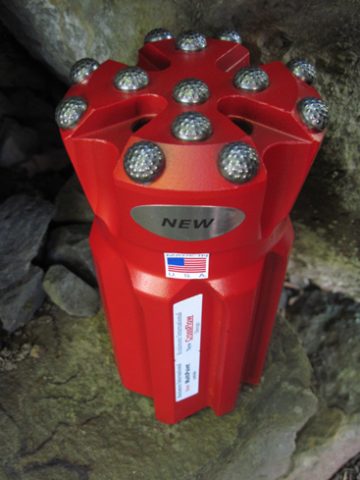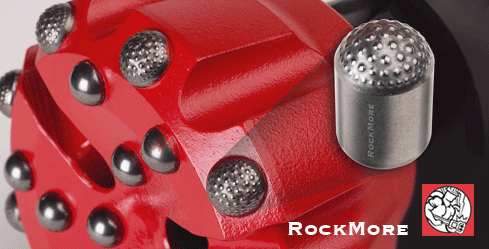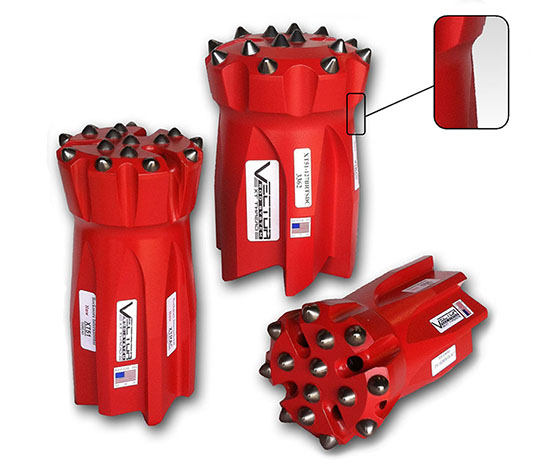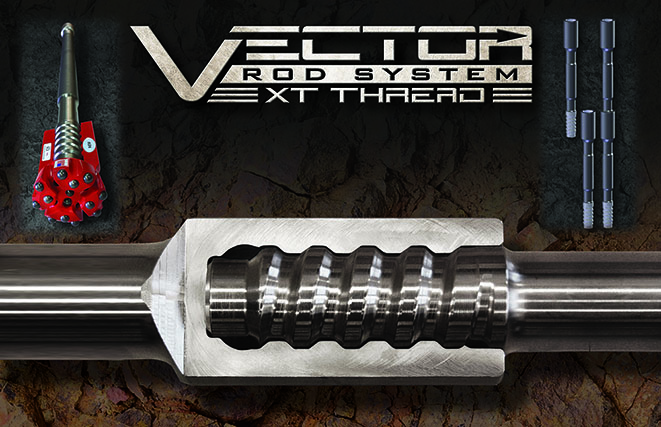
New Drill Bit Design
August 7, 2012
CrossFlow Addition to Rockmore Drill Bits
August 15, 2012Rockmore Announces New CrossFlow Bit Design

Summary: Rockmore International announces a new drill bit design especially suited for hard rock quarry drilling. The new CrossFlow bit design extends bit life and improves penetration rates for percussive drilling applications in abrasive and challenging rock conditions.
Design Intent: Overall drilling efficiency is greatly influenced by bit penetration rates. Increasing rate of bit penetration is mostly determined by impact energy and flushing efficiency. Rockmore has targeted improvements in bit design such that the rock cuttings flush more effectively from the bit face, leading to better penetration rates and increased bit life. The CrossFlow design is intended to provide more efficient rock cutting flushing in order to improve penetration rates and extend bit life.
Design Features: The CrossFlow bit incorporates new design features in the bit face, particularly in the geometry and placement of flush holes, flush grooves, and tungsten buttons. The intent of the new bit geometry is to remove the broken rock chips, that result from the percussive blows, away from the bit face and up towards the hole annulus as quickly and effectively as possible.
The flush holes are placed strictly near the center line of the bit in order to help the flushing medium, usually compressed air for quarry drilling, to more effectively push the rock cuttings away from the bit center towards the bit edge. This direct air path from the bit center to edge provides improved flushing characteristics compared to conventional flush hole positions that are farther from the bit centerline. Standard flush hole positions do not provide adequate flushing medium at the center of the bit, creating a dead zone of rock chips. Such rock chips remain at the center of the bit and prohibit good advancement during the percussion blow cycle, leading to slower penetration rates.
The flush holes are located within newly designed flushing grooves that promote maximum flow of rock cuttings away from the bit face. These V shaped flush grooves are much wider at the bit edge than conventional designs and greatly enhance the ability of the flushing medium to carry the larger rock chips away from the bit face and up towards the hole annulus. In addition, the rock chip velocity is reduced at the wider section of the flush groove at the bit edge, leading to a reduction of steel erosion on the body of the bit. Lowering the erosion factor on the matrix of the bit, known as “body wash”, will extend overall bit life greatly.
The tungsten buttons are placed strategically around and between the flushing holes and grooves such that the carbide buttons contact the rock most effectively with each percussive impact from the bit to the rock face. The ideal contact mechanism between each button and the rock is deep penetration of the tungsten carbide into fresh unbroken rock at each percussion blow. The placement of carbide buttons on the CrossFlow bit design maximizes the effectiveness of the carbides to penetrate and break the rock, resulting in improved penetration rates.
Design Offering: Threaded button bits 89-127mm for Top-Hammer applications. DTH button bits with CrossFlow design currently in development.
Design Benefits: Higher penetration rates; improved bit flushing characteristics; less bit erosion known as body wash; and extended bit life.
By using the Rockmore CrossFlow bit design, drilling operators in quarries can reduce drilling consumable costs and increase their overall drilling efficiencies.



